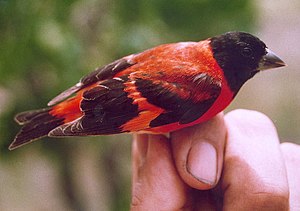Hooded siskin
| Hooded siskin | ||||||||||||
|---|---|---|---|---|---|---|---|---|---|---|---|---|

Hooded siskin ( Spinus cucullatus ) |
||||||||||||
| Systematics | ||||||||||||
|
||||||||||||
| Scientific name | ||||||||||||
| Spinus cucullatus | ||||||||||||
| ( Swainson , 1820) |
The Siskin ( spinus cucullatus , Syn. : Carduelis cucullata ) is a bird art from the subfamily of the Stieglitz-like (Carduelinae).
description
The original hooded siskin is a maximum of 9.5 cm long. It has a red body, black head, black wings, and black tail. The belly and thighs are white. The female is not as strikingly colored as the male. It is more steel-gray in color and only shows a little red color on the chest, back and rump . The wing and tail feathers are not quite as black as the males. Both sexes show a bright red wing mirror.
distribution
The hooded siskin is common in the warm countries of Venezuela and Colombia . The population there is endangered, it is estimated that there are only a few 100 animals left in the wild.
Reproduction
The hen uses plant fibers and animal hair to build a small bowl-shaped nest in a fork of a tree or bush. The three to five whitish eggs are incubated by the female alone. The young birds hatch after about 13 days and are fed by the female alone for the first few days. The male feeds his female on the nest. Only after about five days does the male also feed the young directly, which leave the nest after about 17 days and are then usually looked after by the male alone when the female is already brooding on a new clutch.
The males are quite aggressive towards other conspecifics during the breeding season.
attitude
A good siskin mix (grain feed) serves as food, as is available in stores especially for South American siskins. He prefers chicory , lettuce, chickweed , but also dandelion leaves as green fodder . Semi-ripe seed pods of dandelion , evening primrose, chicory etc. are also very popular. Accustomed animals in well-protected aviaries also overwinter outdoors in Germany.
breed
Due to its nature and appearance, it is very popular with breeders all over the world, so that today it is regularly bred in large numbers and the population, at least in the hands of the breeders, can be regarded as secure.
When kept in pairs, breeding works very well in so-called box cages or aviaries. The temperature should not drop below 20 ° C during breeding.
At the beginning of the last century, German canary breeders began to transfer the red color to the canary by crossing them with hooded siskins . Today we know that some of the color variations known in canaries can be traced back to these crossings. In addition to the red, the mosaic factor and the so-called “optical blue factor” are a legacy of the hooded siskin.
By crossing the Magellanisig in earlier years, the Hooded Siskin has become larger today - 10.5–11 cm.
literature
- Birds of Venezuela by Hilty, ISBN 0-7136-6418-5
- Birds of Trinidad and Tobago , ISBN 0-7136-6759-1
- Finches and Sparrows by Clement, Harris, and Davis, ISBN 0-7136-8017-2
- Kapuzenzeizig - a black market case from the book Save the Birds , by Schreiber, Diamond, Stern and Thielcke, Pro Natur GmbH, Frankfurt, ISBN 3-473-46160-1
Web links
- Entry at Avibase as a monotypical species
- Entry into Birdlife as a critically endangered species
- Info page about the hooded siskin
- Spinus cucullatus inthe IUCN Red List of Threatened Species 2017.3. Listed by: BirdLife International, 2017. Retrieved January 25, 2018.
